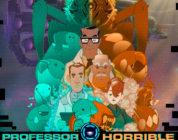It is kind of neat to see Claybook take the approach that it does. The newcomer team at Second Order have attempted to build a world that’s made out of clay, giving players the opportunity to manipulate objects within the environment, whether it’s allowing liquids to form into bowls or solving puzzles in other increasingly creative ways. There are some innovative things here in the game’s design. However, that doesn’t necessarily mean that these ideas translate into good game ideas.
Claybook features wonderfully charming 3D worlds made of clay, where players can roll around with an object of choice and work through puzzles to get ahead. Objective points are marked clearly and the tutorial gives a pretty good idea of how to manipulate things at the outset of the game. Actions available include digging within the environment and performing rewinds and some clay objects stay behind to help navigate a little easier; it’s a neat mechanic. Unfortunately, it doesn’t always work flawlessly, as it’s too easy to get stuck within a level, often forcing a reset.
What’s more, the puzzles themselves don’t really offer the right kind of challenge. At first, they’re easy going but eventually, they become mundane to the point that it doesn’t feel like much progress is being made. Sure, the game looks good, but if there’s not much fun or a challenge to be had, what was the point exactly?
There are 20 main levels within the game and even though there are cute little things to discover here and there, the variety doesn’t last too long. It is cool to change into different types of shapes, but the game could’ve used more creativity, not to mention a friendlier camera.
Getting around and seeing where to go next is just more work than it should be.
I do like the idea of rewinding time and “eating” through objects. Again though, I really think more could’ve been done within this world to make the player feel like they have complete control. Even the special endless-runner levels don’t offer much, though it is pretty cool to try them out and see what kind of times can be achieved.
Fortunately, the progression system doesn’t force players to get a perfect run or complete every single objective. Players can actually half-complete a level and see what else the game has to offer, without having to feel like a 100-percent completionist. This allows players to check out more of Second Order’s designs without being burdened with the timesink.
There is a neat level creator that some players may want to try out but it’s a little too complicated for its own good. We attempted to build two different levels, and while we were eventually successful, the community doesn’t seem to be big enough just yet to provide that much-needed variety and unique takes on the tools at hand that other maker modes provide.
Although, if there’s a desire to play with clay without getting one’s hands dirty, Claybook provides.
All in all, the game benefits from some beautiful clay-built world designs, which flows smoothly. Some of the objects are fun to watch when terraforming around a level or squishing through an obstacle but the camera is a pain. Also, why does the kid that’s watching everything look so creepy? Lighten up, kid. The music’s okay at best but doesn’t really add much to the game. At least the sound effects are spot on.
Claybook is a game that could’ve easily built upon its foundation (like actual clay) with a little bit of better programming and the inclusion of more options. As it stands, the potential is there to be a truly great game, but it’s not quite strong enough to get there. Not yet, anyway.
For more review action, check out my take on the release of the Turok remaster that recently hit the Switch or for something a little different take a look at this unique NES homebrew game.





